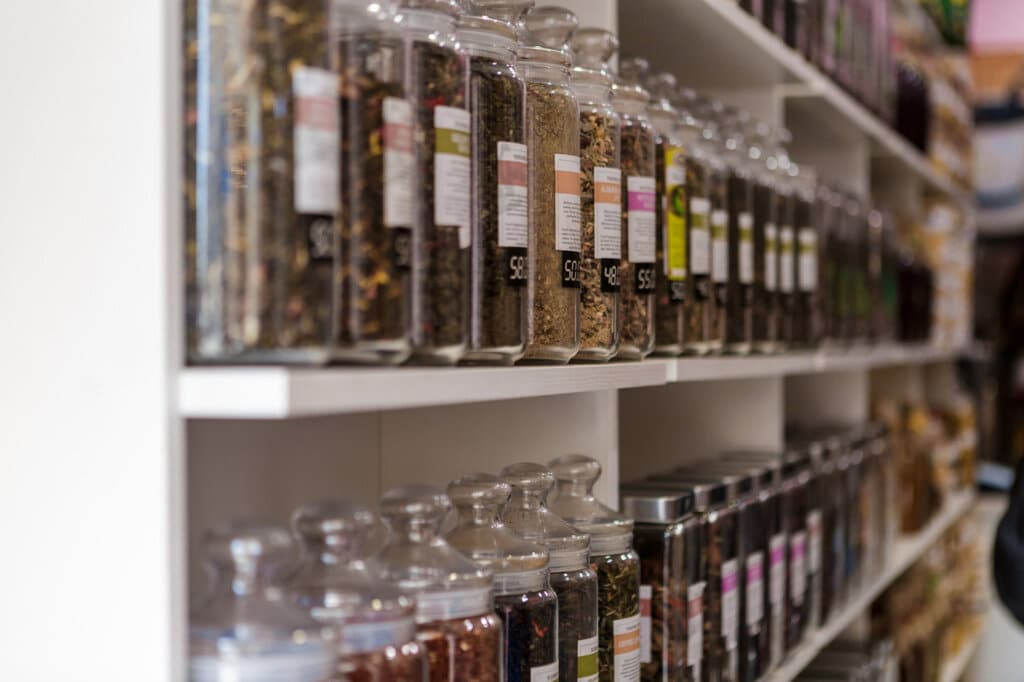What is PCOS
Polycystic Ovary Syndrome (PCOS) is a hormonal disorder that can cause infertility in women. The prevalence is anywhere from 5-10% in women of reproductive age (1). The symptoms include irregular periods, hair loss, facial hair, acne, and infertility. Anywhere from 40-80% of people with PCOS are overweight, and insulin resistance is a common trait in women with the disease (2).

A Brief Overview of Insulin and Blood Sugar
To understand insulin resistance, it’s essential to see how a normal insulin response reacts. When you eat, your body takes food and converts it into blood sugar (glucose). When blood sugar rises, it triggers insulin to be released from the pancreas. Insulin is a hormone that helps blood sugar enter the cell so it can be used for energy or stored for later. Without insulin, the blood sugar has nowhere to go and remains in the bloodstream.
When there are high blood sugar levels, the pancreas will initially try to produce more insulin to keep up. Higher levels of insulin and lower blood sugar levels can lead to hypoglycemic symptoms such as dizziness, irritability, sweating, and shakiness when hungry. Over time the cells that previously recognized insulin become desensitized, or resistant. You can picture it like the cell is a lock and insulin is the key to let glucose in, only with insulin resistance the cells have changed their locks, so the key no longer works. Our cells’ ability to recognize insulin is also known as insulin sensitivity.

How do high insulin levels impact sex hormones and ovulation?
High levels of insulin increase androgens, which are a group of sex hormones that include testosterone. This increased testosterone level is what causes thinning hair, facial hair, and acne that are common in PCOS. Insulin influences androgens directly by increasing production in the ovaries and indirectly by regulating levels of sex hormone-binding globulin (SHBG) (3, 4). Too much insulin inhibits SHBG production, which prefers to bind with sex hormones, including androgens like the name says. Without enough SHBG, there are increased amounts of androgens that are available. Excess androgens in women lead to metabolic dysfunction, inflammation, increased fat, and increased risk of Type 2 Diabetes.
Improving insulin sensitivity and reducing the amount of insulin produced to normal levels beneficially impacts women with PCOS.

Excess androgens produced from high insulin levels are converted to estrogen, which stimulates luteinizing hormone (LH) (3). You may have heard of ovulation tests. They analyze how much LH is in your urine and predict when ovulation occurs. In a normal menstrual cycle, LH stimulates ovulation, but with high insulin levels, there is increased LH secretion and premature differentiation of follicular cells, which results in the absence of ovulation (anovulation).
Improving insulin sensitivity improves ovulation rates, fertility, and birth rates (6).
Natural ways to promote blood sugar balance and insulin sensitivity

Herbal medicine for blood sugar
Herbs/Spices
There are a variety of herbs and spices that can modulate pathways in insulin resistance (7, 8):
Milk Thistle– a well-known herb for detoxification and liver health, has found itself front and center as a potent insulin sensitizer. It helps to reduce lipids and lower blood sugar by increasing insulin sensitivity. Milk thistle brings with it the benefits of reducing inflammation and quenching oxidative stress with its antioxidant properties.
- Cinnamon– regulates blood sugar by improving insulin signaling. Cinnamon is a great topping that can be added to many things, including sweet potatoes, as a healthy treat.
- Turmeric– a potent anti-inflammatory, antioxidant, and immunoregulator. Turmeric increases insulin levels after a meal and improves beta-cell function in the pancreas. Turmeric is a spice that can be used in meals or bought in supplement form.
- Licorice– has compounds that reduce blood sugar and activate its metabolism through protein regulating genes.
- Astragalus Polysaccharides– increase insulin sensitivity and balance blood sugar. It is an antioxidant, anti-inflammatory, and has immune regulating properties.
- Fenugreek– has been shown to increase insulin sensitivity and reduce inflammation.

Nutrition
To manage insulin resistance, the amounts and types of carbohydrates, fat, and fiber are all essential factors that influence blood sugar balance and insulin secretion.
Refined carbohydrates should be avoided at all costs because it spikes blood sugar and complex carbohydrates should be paired with lean protein and healthy fats.
People with insulin resistance should limit carbohydrates to 50g a day to improve insulin sensitivity and help restore balanced blood sugar. It’s essential to read the food labels and count how many carbohydrates you’re eating at each meal. Carbohydrate sources should be complex carbohydrates such as fruits, vegetables, and beans. They contain fiber and slow down the absorption of sugar from our foods. Limiting snacking between meals also helps reduce insulin and blood sugar levels. Healthy fats like fish oil, olive oil, chia seeds, and nuts can help reduce inflammation, improve insulin response, and balance blood sugar (9). Lower carbohydrate and higher healthy fat intakes decrease fasting glucose, insulin, and triglycerides.
- Metabolic flexibility refers to the ability of the body to adapt to changes in metabolic demand. Insulin resistance shows a metabolic inflexibility in its inability to adapt to increased energy input. Nutritional therapies can be used to help improve metabolic flexibility and insulin sensitivity (any nutritional treatment should be guided and closely monitored by a professional):
- Intermittent Fasting– this strategy focuses on restricting food consumed, whether that’s 24 hours a couple days a week or a period within the day (e.g., 14-18 hours). This approach has shown improvement in insulin sensitivity, beta-cell function, and reduced blood pressure (10). Careful monitoring of hypoglycemia, hyperglycemia, and ketoacidosis is essential.
- Carb Cycling– this approach transitions between eating high amounts of complex carbohydrates (50-65%) on certain days to eating low amounts (below 10% or 50g) on others. This can help improve insulin sensitivity and metabolic flexibility by allowing cells to repair and reduce inflammation and oxidative stress.
- Low Carbohydrate Diet– eating less than 130g/day of carbohydrates or 26% of daily energy from carbohydrates is considered “low carbohydrate.” This diet can improve glucose metabolism and insulin sensitivity (11).
- Ketogenic Diet/Very Low Carbohydrate Diet– eating less than 55g/day of carbohydrates and eating mainly protein and fats is considered a ketogenic diet (also called a very low-carbohydrate diet). Ketogenic diets can help people lose weight, regulate fasting glucose, and improve lipid metabolism (12). Due to the risks of ketoacidosis, it’s important to consult with a doctor before attempting.
There are also more targeted nutritional elements you can implement (7, 13, 14):
- Anthocyanins in blueberries- a powerful antioxidant that improves insulin resistance and diabetes. Blueberries can be topped on yogurt, oatmeal, smoothies, or just eaten on their own!
- Myo-inositol– can be taken in food or supplement form. It is found in fiber-rich foods like beans, sesame seeds, and citrus fruits. Myo-inositol reduces insulin levels and increases insulin sensitivity in women with PCOS.
- Quercetin– a flavonoid found in apples, berries, green tea, and onions. It can lower blood sugar after meals by reducing intestinal glucose absorption.
- Resveratrol– is a powerful antioxidant, anti-inflammatory, and immunomodulator. It activates pathways similar to exercise that regulate insulin. It also acts on beta-cells in the pancreas to prevent cell death and enhance insulin secretion. Resveratrol can be found in grapes, wine, cocoa, and blueberries or taken in supplement form.
- Indole-3-carbinol and DIM– compounds found in cruciferous vegetables like Brussels sprouts, cabbage, collards, and mustard greens. These compounds regulate carbohydrate metabolism, decrease blood sugar, and decrease insulin levels.
If you’re interested in learning more about your own insulin sensitivity and glucose levels or optimizing your hormones for fertility and PCOS you can schedule an introductory call with Dr. Guan by using the link below.
Citations
1. Rondanelli, M., Perna, S., Faliva, M., Monteferrario, F., Repaci, E., & Allieri, F. (2014). Focus on metabolic and nutritional correlates of polycystic ovary syndrome and update on nutritional management of these critical phenomena. Archives of Gynecology and Obstetrics, 290(6), 1079–1092. https://doi.org/10.1007/s00404-014-3433-z
2. Sam, S. (2007). Obesity and polycystic ovary syndrome. Obes Manag., 3(2), 69–73. doi:10.1089/obe.2007.0019
3. Sakumoto, T., Tokunaga, Y., Tanaka, H., Nohara, M., Motegi, E., Shinkawa, T., … Higashi, M. (2010). Insulin resistance/hyperinsulinemia and reproductive disorders in infertile women. Reproductive Medicine and Biology, 9(4), 185–190. https://doi.org/10.1007/s12522-010-0062-5
4. Navarro, G., Allard, C., Xu, W., & Mauvais-Jarvis, F. (2015). The role of androgens in metabolism, obesity, and diabetes in males and females. Obesity, 23(4), 713–719. https://doi.org/10.1002/oby.21033
5. Baptiste, C. G., Battista, M. C., Trottier, A., & Baillargeon, J. P. (2010). Insulin and hyperandrogenism in women with polycystic ovary syndrome. Journal of Steroid Biochemistry and Molecular Biology, 122(1–3), 42–52. https://doi.org/10.1016/j.jsbmb.2009.12.010
6. Heathcote, G., Boothroyd, C., Forbes, K., Lee, A., Gregor, M., & Luscombe, G. (2020). Ovulation Rate after Metformin and Clomiphene vs Clomiphene Alone in Polycystic Ovary Syndrome (PCOS): A Randomized, Double-Blind, Placebo-Controlled Trial. Fertility & Reproduction, 02(01), 32–36. https://doi.org/10.1142/s2661318220500061
7. Chang, C. L. T., Lin, Y., Bartolome, A. P., Chen, Y. C., Chiu, S. C., & Yang, W. C. (2013). Herbal therapies for type 2 diabetes mellitus: chemistry, biology, and potential application of selected plants and compounds. Evidence-Based Complementary and Alternative Medicine, 2013. https://doi.org/10.1155/2013/378657
8. Kazazis, C. E., Evangelopoulos, A. A., Kollas, A., & Vallianou, N. G. (2014). The therapeutic potential of milk thistle in diabetes. Review of Diabetic Studies, 11(2), 167–174. https://doi.org/10.1900/RDS.2014.11.167
9. Imamura, F., Micha, R., Wu, J. H. Y., de Oliveira Otto, M. C., Otite, F. O., Abioye, A. I., & Mozaffarian, D. (2016). Effects of Saturated Fat, Polyunsaturated Fat, Monounsaturated Fat, and Carbohydrate on Glucose-Insulin Homeostasis: A Systematic Review and Meta-analysis of Randomised Controlled Feeding Trials. PLoS Medicine, 13(7), 1–18. https://doi.org/10.1371/journal.pmed.1002087
10. Muñoz-Hernández, L., Márquez-López, Z., Mehta, R., & Aguilar-Salinas, C. A. (2020). Intermittent Fasting as Part of the Management for T2DM: from Animal Models to Human Clinical Studies. Current Diabetes Reports, 20(4). https://doi.org/10.1007/s11892-020-1295-2
11. Meng, Y., Bai, H., Wang, S., Li, Z., Wang, Q., & Chen, L. (2017). Efficacy of low carbohydrate diet for type 2 diabetes mellitus management: A systematic review and meta-analysis of randomized controlled trials. Diabetes Research and Clinical Practice, 131, 124–131. https://doi.org/10.1016/j.diabres.2017.07.006
12. Yuan, X., Wang, J., Yang, S., Gao, M., Cao, L., Li, X., … Sun, C. (2020). Effect of the ketogenic diet on glycemic control, insulin resistance, and lipid metabolism in patients with T2DM: a systematic review and meta-analysis. Nutrition and Diabetes, 10(1). https://doi.org/10.1038/s41387-020-00142-z
13. Unfer, V., Carlomagno, G., Dante, G., & Facchinetti, F. (2012). Effects of myo-inositol in women with PCOS: A systematic review of randomized controlled trials. Gynecological Endocrinology, 28(7), 509–515. https://doi.org/10.3109/09513590.2011.650660
14. Poornima, J., & Mirunalini, S. (2014). Regulation of carbohydrate metabolism by indole-3-carbinol and its metabolite 3,3′-diindolylmethane in high-fat diet-induced C57BL/6J mice. Molecular and Cellular Biochemistry, 385(1–2), 7–15. https://doi.org/10.1007/s11010-013-1808-2




